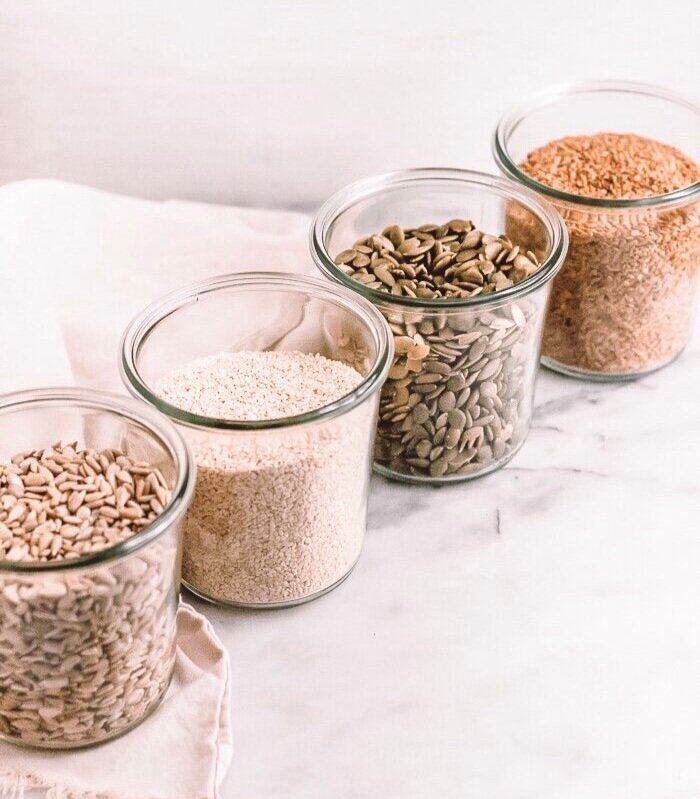Seed Cycling Benefits for Hormones, Fertility and Women’s Health
Seed cycling, a health practice gaining popularity, is known for its potential to balance hormones and address fertility issues in women. Rooted in traditional health practices, this holistic approach has been embraced for its various benefits for females – particularly, for hormone and fertility health. In this post, we delve into the world of seed cycling, exploring 15 distinct advantages it offers, ranging from hormonal balance and fertility support to skincare and weight management. I started seed cycling recently and I already notice a difference in my cycle! Start reaping the benefits of seed cycling by incorporating nutrient-rich options like flax and pumpkin seeds into your daily routine.

Understanding Seed Cycling:
Understand how seed cycling aligns with the phases of the menstrual cycle to naturally support hormonal fluctuations. Seed cycling involves a dietary approach where specific seeds, such as flax and pumpkin seeds during the follicular phase and sesame and sunflower seeds during the luteal phase of the menstrual cycle, are consumed in a systematic manner. Advocates claim that this practice helps regulate estrogen and progesterone levels, promoting overall hormonal balance.
How Seed Cycling Works:
Seed cycling works by utilizing the nutritional components of specific seeds to influence hormonal production during different phases of the menstrual cycle. Flax and pumpkin seeds, rich in omega-3 fatty acids, are consumed during the follicular phase to support estrogen production. During the luteal phase, sesame and sunflower seeds, known for their antioxidants, are included to promote progesterone production.
During the Follicular Phase:
- Flaxseeds: Rich in omega-3 fatty acids, flaxseeds support balanced estrogen levels. This is crucial for the development of the dominant follicle and the preparation of the uterine lining.
- Pumpkin Seeds: Packed with zinc and other essential minerals, pumpkin seeds contribute to reproductive health by supporting immune function and hormone regulation.
Consuming a daily mix of freshly ground flaxseeds and pumpkin seeds during the follicular phase provides the body with the nutrients needed to promote optimal conditions for egg maturation and estrogen balance.
During the Luteal Phase:
- Sesame Seeds: These seeds contain lignans that have estrogen-modulating effects. By promoting a healthy balance of estrogen and progesterone, sesame seeds contribute to a receptive uterine environment.
- Sunflower Seeds: Rich in selenium and vitamin E, sunflower seeds support overall reproductive health and may contribute to the luteal phase’s stability.

In the luteal phase, incorporating freshly ground sesame and sunflower seeds into your daily routine provides the body with essential nutrients that support progesterone production and maintain hormonal equilibrium.
Seed Cycling Benefits for Womens Health
Seed cycling goes beyond supporting reproductive health; it offers a range of benefits impacting various aspects of well-being. Let’s delve into these categories and explore the advantages each brings:
Seed Cycling Benefits for Skin
Seed cycling, particularly with the inclusion of flax and pumpkin seeds, can significantly benefit the skin. These seeds are rich in omega-3 fatty acids, which possess anti-inflammatory properties. This anti-inflammatory effect contributes to reducing skin inflammation associated with various skin conditions, promoting a clearer complexion. Additionally, the hormonal balance achieved through seed cycling may positively influence overall skin health, potentially reducing acne and enhancing a radiant appearance.
Anti-Inflammatory Properties:
Flax and pumpkin seeds contain omega-3 fatty acids with potent anti-inflammatory effects, which can alleviate skin inflammation and redness.
Hormonal Balance:
The hormonal equilibrium achieved through seed cycling positively impacts skin health, potentially leading to a reduction in acne and promoting a healthy, glowing complexion.
Visible improvements in skin health may vary among individuals, but some may experience positive changes within a few menstrual cycles of consistent seed cycling.
Benefits for Fertility
Seed cycling presents a natural and gentle solution for women struggling with fertility issues. By incorporating specific seeds during different menstrual phases, individuals aim to regulate hormonal levels crucial for conception. The essential fatty acids in flax, pumpkin, sesame, and sunflower seeds contribute to a healthy reproductive system, creating an environment conducive to fertility.
Hormonal Regulation:
Flax and pumpkin seeds during the follicular phase, and sesame and sunflower seeds during the luteal phase, help regulate estrogen and progesterone levels, crucial for fertility.
Reproductive System Support:
Essential fatty acids in the seeds contribute to the overall health of the reproductive system, fostering an environment conducive to conception.
Improvements in fertility may vary, but consistent seed cycling over several menstrual cycles is generally recommended for optimal results.
Benefits for Weight Loss
Seed cycling’s impact on hormonal balance extends to metabolism and weight management. By promoting a harmonious interplay between estrogen and progesterone, seed cycling may help regulate appetite and support healthy weight loss. The incorporation of specific seeds during different phases aligns with the body’s natural rhythms, potentially enhancing the effectiveness of weight management efforts.
Hormonal Balance:
Seed cycling helps maintain a balance between estrogen and progesterone, influencing metabolism and supporting healthy weight management.
Appetite Regulation:
The harmonious interplay of hormones achieved through seed cycling may contribute to appetite regulation, aiding in weight loss efforts.
Individual responses may vary, but some individuals may notice positive changes in weight and metabolism after a few menstrual cycles of consistent seed cycling.
Seed Cycling Benefits for Breast Cancer Prevention
Certain seeds, particularly flaxseeds, may play a role in breast cancer prevention. Studies suggest that these seeds contain compounds, such as lignans, which exhibit protective effects against breast cancer. The antioxidant properties of flaxseed lignans, coupled with their potential to modulate estrogen levels, could contribute to reducing the risk of hormone-related cancers, including breast cancer.
Lignan Content:
Flaxseeds, a key component of seed cycling, contain lignans with antioxidant properties that may contribute to the prevention of breast cancer.
Estrogen Modulation:
The lignans in flaxseeds have the potential to modulate estrogen levels, offering a protective effect against hormone-related cancers, including breast cancer.
While individual responses may vary, incorporating seed cycling into the diet over an extended period may contribute to long-term benefits for breast cancer prevention.
Seed Cycling Benefits for Hormonal Imbalance
Hormonal imbalances, presenting as irregular periods and mood swings, can be addressed holistically through seed cycling. By providing the body with essential nutrients for optimal hormonal function, seed cycling offers a natural approach to promote a more regular menstrual cycle and improved mood stability.
Nutrient Support:
Seed cycling supplies the body with essential nutrients, aiding in optimal hormonal function and addressing imbalances that manifest as irregular periods and mood swings.
Hormonal Regulation:
Consistent practice of seed cycling contributes to a more regular menstrual cycle and improved mood stability by supporting balanced hormone levels.
Individuals may experience improvements in hormonal balance and mood stability after several menstrual cycles of dedicated seed cycling.
Seed Cycling Benefits for Postmenopausal Women
While often associated with reproductive health, seed cycling’s benefits extend to postmenopausal women. The nutrients in flax, pumpkin, sesame, and sunflower seeds support overall health during the postmenopausal phase. Seed cycling may assist in managing symptoms associated with hormonal changes during menopause, such as hot flashes and mood swings.
While often associated with menstrual health, seed cycling also holds promise for postmenopausal women seeking hormonal balance.
Nutrient Support:
Seeds provide essential nutrients that support overall health and well-being during the postmenopausal phase.
Symptom Management:
Seed cycling may help manage symptoms like hot flashes and mood swings associated with hormonal changes during menopause.
Continuous incorporation of seed cycling into the diet may lead to gradual improvements in postmenopausal symptoms over time.
Seed Cycling Benefits for Irregular Periods
Irregular menstrual cycles can be a source of frustration, but seed cycling offers a natural approach to regulate periods. By harnessing the power of specific seeds to influence hormonal fluctuations, seed cycling may contribute to a more predictable and balanced menstrual cycle over time.
Hormonal Influence:
Specific seeds used in seed cycling influence hormonal fluctuations, promoting a more predictable and balanced menstrual cycle.
Regulatory Effect:
Consistent practice of seed cycling helps regulate periods, offering a natural solution to irregular menstrual cycles.
Improvement in menstrual regularity may vary, but individuals may notice positive changes after several menstrual cycles of dedicated seed cycling.
Seed Cycling Benefits for Hormonal Birth Control Users
For individuals using hormonal birth control, such as oral contraceptives, seed cycling provides a supportive strategy during the transition off these medications. The nutrients in flax, pumpkin, sesame, and sunflower seeds aid the body in regaining hormonal balance after discontinuing hormonal birth control methods. For example, some research suggests sesame seeds cycling for hormone balance can positively help those on birth control.
Hormonal Balance Support:
Nutrients in seeds support the body in regaining hormonal balance after discontinuing hormonal birth control methods.
Transition Support:
Seed cycling offers a supportive strategy during the transition off hormonal birth control, helping the body readjust.
Seed Cycling Benefits for Estrogen and Progesterone Levels
Understand the role of seed cycling in modulating estrogen levels, offering a natural approach to hormonal well-being. The careful selection of seeds during each menstrual phase in seed cycling aims to support the production of estrogen and progesterone, essential hormones for reproductive health. Fluctuations in these hormones can impact fertility, mood, and overall well-being, making seed cycling a natural way to nurture the delicate balance between estrogen and progesterone. Some research suggest the positive impact of seed cycling on progesterone levels, offering a natural approach to hormonal equilibrium.
Hormonal Support:
Seed cycling provides essential nutrients to support the production of estrogen and progesterone, crucial for reproductive health.
Balance Restoration:
By aligning with the body’s natural rhythms, seed cycling helps restore and maintain the delicate balance between estrogen and progesterone.
Individual responses may vary, but consistent practice of seed cycling over multiple menstrual cycles is recommended for sustained benefits in estrogen and progesterone balance.
Eating Specific Seeds
Incorporating a variety of seeds into the diet provides a spectrum of nutrients crucial for overall health. Flaxseeds, rich in omega-3 fatty acids, contribute to heart health, while pumpkin seeds provide essential minerals like magnesium and zinc. Sesame and sunflower seeds offer additional nutrients, creating a well-rounded nutritional profile.
Freshly Ground Seeds
Freshly grinding seeds before consumption ensures the maximum retention of their nutritional value. This practice enhances the absorption of nutrients, allowing the body to fully utilize the benefits of seed cycling. Grinding seeds also releases essential oils, intensifying the flavors and enhancing the overall culinary experience.

Incorporating seed cycling into your wellness routine requires consistency and patience. Many individuals begin to notice subtle changes within a few menstrual cycles, while others may take longer to experience the full spectrum of benefits. As with any holistic approach, it’s essential to listen to your body and consult with a healthcare professional, especially if you have underlying health conditions or concerns.
How to Incorporate Seed Cycling for Optimal Results
To reap the full benefits of seed cycling, consider the following tips:
Freshly Grind Seeds:
Grinding seeds just before consumption ensures maximum nutrient absorption. Invest in a quality grinder to make this process quick and easy.
Consistency is Key:
Seed cycling is most effective when practiced consistently. Incorporate the designated seeds into your daily diet, paying attention to the specific seeds recommended for each phase.
Mindful Consumption:
Be mindful of portion sizes. While seeds offer numerous health benefits, moderation is essential. Aim for a balanced and varied diet to complement seed cycling.
Listen to Your Body:
Everyone’s body responds differently. Pay attention to how your body reacts to seed cycling, and adjust the quantities if needed. Consulting with a healthcare professional can provide personalized guidance.
Integrate Seeds Creatively:
Experiment with different ways to incorporate seeds into your meals. Sprinkle them on salads, blend them into smoothies, or add them to yogurt for a diverse and enjoyable experience.
In conclusion, seed cycling presents a holistic approach to women’s health, offering benefits across various facets of well-being. Whether you’re navigating fertility concerns, seeking hormonal balance, or aiming for radiant skin, the diverse advantages of seed cycling make it a versatile and appealing wellness practice. Embrace the journey, listen to your body, and savor the wholesome benefits of seed cycling.
Explore related topics:






I have never heard of this. It’s so interesting. A great read. I am a women’s wellness and lifestyle blogger, too. Let’s be friends!